05.12.2017
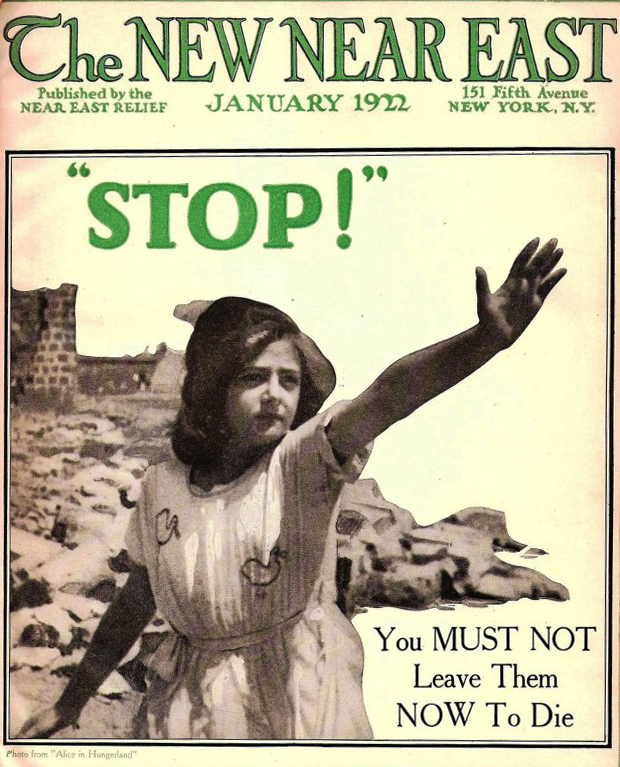
Esther, who played the leading part in the movie Alice in Hungerland,
on the front page of The New Near East periodical.
The New Near East, January 1922
In 1915 a number of prominent Americans at the request of Henry Morgenthau, the US Ambassador to the Ottoman Empire, founded the Near East Relief Committee, which aimed “to provide relief and to assist in the repatriation, rehabilitation, and the reestablishment of suffering and dependent people of the Near East and adjacent areas, as well as to provide for the care of orphans and widows …” (1) For the purpose of organizing donations and fundraising, the members of the Relief Committee began a large-scale campaign.
For more effective fundraising conditions were created at the end of World War I. It provided the broader layers of the society an opportunity better to understand the Near East tragedy through photographs and moving pictures. Using the power of visual image and realizing the impact of photographs of desperate Armenian refugees and orphans to capture the sentiments of the society, documentary and feature films were screened.
In order to create such movies the Committee members, photographers, producers and filmmakers were sent to the Near East. In 1921, Mrs. Florence Spencer Duryea, as a member of the film crew of the Near East Relief Committee, arrived in Constantinople. Mrs. Florence Spencer Duryea was with the organization from the very first years of the Committee's creation, and was particularly interested in Armenian refugees and orphans. Being the National Director of Women’s Organizations for the institution, she frequently spoke about Near East Relief’s work and was quoted in prominent publications such as the
New York Times and the
Woman Citizen. The filmmakers planned to make a new type of silent film about Near East Relief’s work. Inspired by Lewis Carroll’s similarly-named children’s book
Alice in Wonderland, Alice in Hungerland would explain Near East Relief’s work in a child-friendly format (2). A dramatic story of one child could have been more effective, than the history of a whole crowd of starving people. During her visits to the committee's orphanages in Ortakeuy, Mrs. Duryea met an eight-year-old girl named Ester. The filmmakers soon offered her the main role in
Alice in Hungerland. Esther Razon was born in Constantinople in 1912 to Ottoman Jewish parents. Esther's parents died during the First World War, and she lost five siblings to illness and malnutrition. Esther sought refuge in the Jewish National Orphans’ Home in Constantinople (3).
In
Alice in Hungerland, Esther played an eight-year-old American girl in the film, whose father, as a Near East Relief worker, was in the Near East. Alice stows away on a cargo ship filled with food, clothing and supplies donated by the American people and bound for the Near East. She reached her father in Constantinople and continued with him “over the Black Sea to Batum and then to Tiflis, Alexandrapol and Erivan. During that time period Alice visited the Near East Relief orphanages, where Armenian orphans taught her Armenian national songs and dances, she also saw the orphans, who were waiting for their turn to enter the orphanage, and distributed bread to them (4). The film included unscripted footage taken by NER cinematographers at the Near East Relief orphanages, and out of their walls. These scenes offered an opportunity to show the Anerican people the desperate circumstances in which the Armenians lived. The juxtaposition between the “homeless, starving children on the streets, often sleeping next to dogs,” and “the neat, cheerful children in the Committee’s orphanages”(5) pictured the huge amount of work done by the Bear East Relief. At the same time, the film called for more active participation in fundraising and donations.
The three-reel feature film premiered at the Yale Club in New York City on November 29, 1921. The film made great success, especially among children. In many US cities children paid “admission” to see
Alice in Hungerland with a can of condensed milk. In January 1921 alone, by the initiative of Boy Scouts, the children wishing to watch the movie in White Plains, NY contributed 5,000 cans of condensed milk (6). In some cities, the offices of the Relief Committee were distributing free tickets to schoolchildren, thus trying to raise awareness among children, which would result in larger amounts of donations (7).
After the film's shoot, Mrs. Duryea adopted Esther and led her to New York. The Jewish National Orphans’ Home in Constantinople and the Board of Trustees of the Near East Relief Committee were consistent that Esther, now Alice Duryea, would grow up in Jewish traditions in order to preserve her cultural heritage (8). Articles about Esther's participation in the film, and Esther's fate were printed in
The New Near East and The New York Times (9). After moving to the US with Esther, Mrs. Duryea remained active in Near East Relief. Together they traveled on the East Coast of the US traveled to nearly every large city on the East Coast to promote
Alice in Hungerland and meet the audience and present the situation of the orphans in the Middle East (10). They organized eastern bazaars in support of Near East Industries where handicrafts of refugees were sold. In 1931 alone $100,000 from the sale of refugee embroideries was raised (11).
All the proceeds from the screening of the movie
Alice in the Hungerland were allocated to save more than 130000 lives in the Near East. Unfortunately, no part of the movie has been found yet. After a century, in 2010, Ester Razon, who played Alice's role in the movie, was awarded by Near East Foundation with a Medal of Honor for the work done for the Near East orphans (12).
Esther Razon passed away in November 2015 in Butte city, US, at the age of 103.(13)
Lusine Abrahamyan, AGMI research fellow
_________________________________________________________________
1. http://www.armenian-genocide.org/Affirmation.228/current_category.7/offset.50/affirmation_detail.html.
2. «Ալիսան սովյալների աշխարհում» վերնագիրը պատահական չէր ընտրված: Ինչպես «Ալիսան հրաշքների աշխարհում» գրքում, այնպես էլ ֆիլմում Ալիսան ճամփորդելու էր և այդ ընթացքում ականատեսը դառնալու այնպիսի երևույթների, որոնք ազդելու էին նրա հուզական աշխարհի և մանկական հոգեբանության վրա: Ինչպես գրքում, այնպես էլ ֆիլմում, Ալիսան տեսնելու էր մարդկանց, ովքեր պայքարում էին հանգամանքների դեմ հանուն իրենց գոյության, և փորձելու էր անել հնարավոր ամեն բան նրանց օգնելու համար:
3. Մերձավոր Արևելքի նպաստամատույցը համագործակցում էր Կոստանդնուպոլսի հրեական համայնքի հետ և նյութական օժանդակություն ցույց տալիս համայնքի ջանքերով ստեղծված Օրթաքյոյի և Հասքյոյ որբանոցներին:
4. “Alice in Hungerland,” The New Near East, no. 7, November 1921, p. 4.
5. Նույն տեղում:
6. “Are They a Worthy People?” The New Near East 7, no. 4, February 1922, p. 16.
7. “The Power of Children,” The New Near East 7, no. 2, December 1921, p. 14.
8. Մերձավոր Արևելքի նպաստամատույց կոմիտեն չէր խրախուսում կոմիտեի կին աժխատակիցներին որդեգրել և իրենց հետ ԱՄՆ տեղափոխել Մերձավոր Արևելքի որբերին՝ պայմանավորված այն հանգամանքով, որ ամերիկյան իշխանությունները դժկամություն էին դրսևորում, իսկ որդեգրող կանայք մեծամասամբ միայնակ էին:
9. http://search.archives.jdc.org/multimedia/Documents/NY_AR2132/436-442/NY_AR2132_00663.pdf.
10. http://query.nytimes.com/mem/archive-free/pdf?res=9C06E0D81E3CE533A2575BC2A9629C946395D6CF.
11. https://www.newspapers.com/clip/10006404/florence_spencer_duryea_1922/.
12. https://www.newspapers.com/clip/10006825/florence_spencer_duryea_1931/.
13. http://mtstandard.com/news/local/obituaries/alice-duryea-kinney/article_3a72e875-b153-50f7-be7b-a37a2a55e7ff.html.
14. Նույն տեղում:
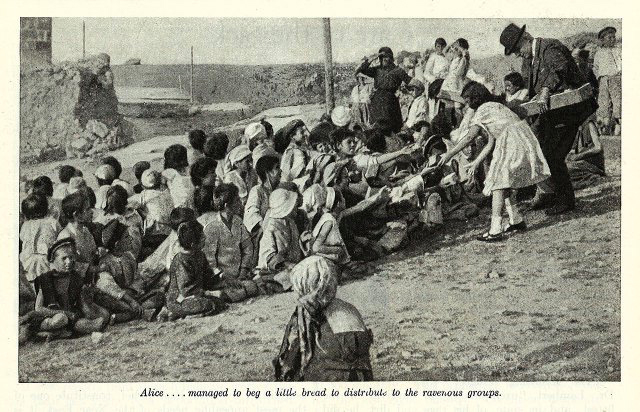
Alice distributes bread to homeless orphans. A scene from the movie Alice in Hungerland.
The New Near East, November 1921, p. 5.
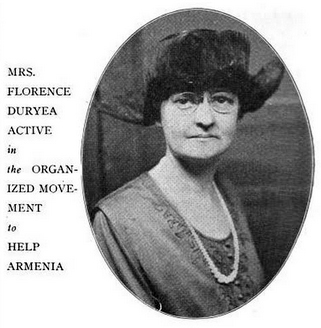
Florence Spencer Duryea (1884-1966)
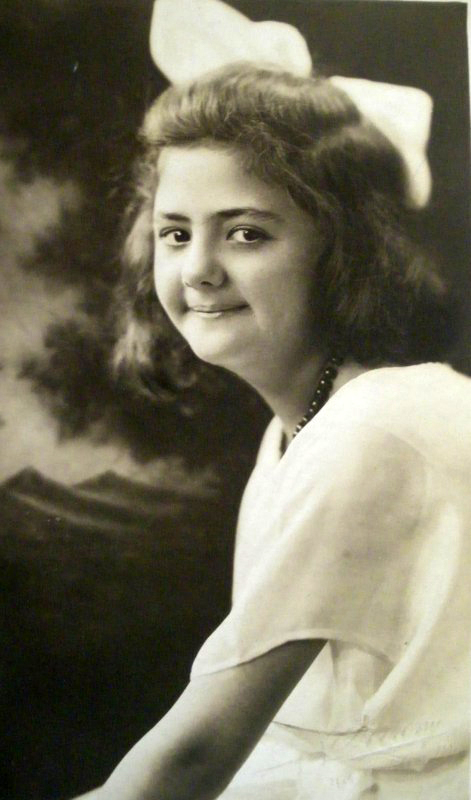
Photo of Esther Razon in USA, 1920s
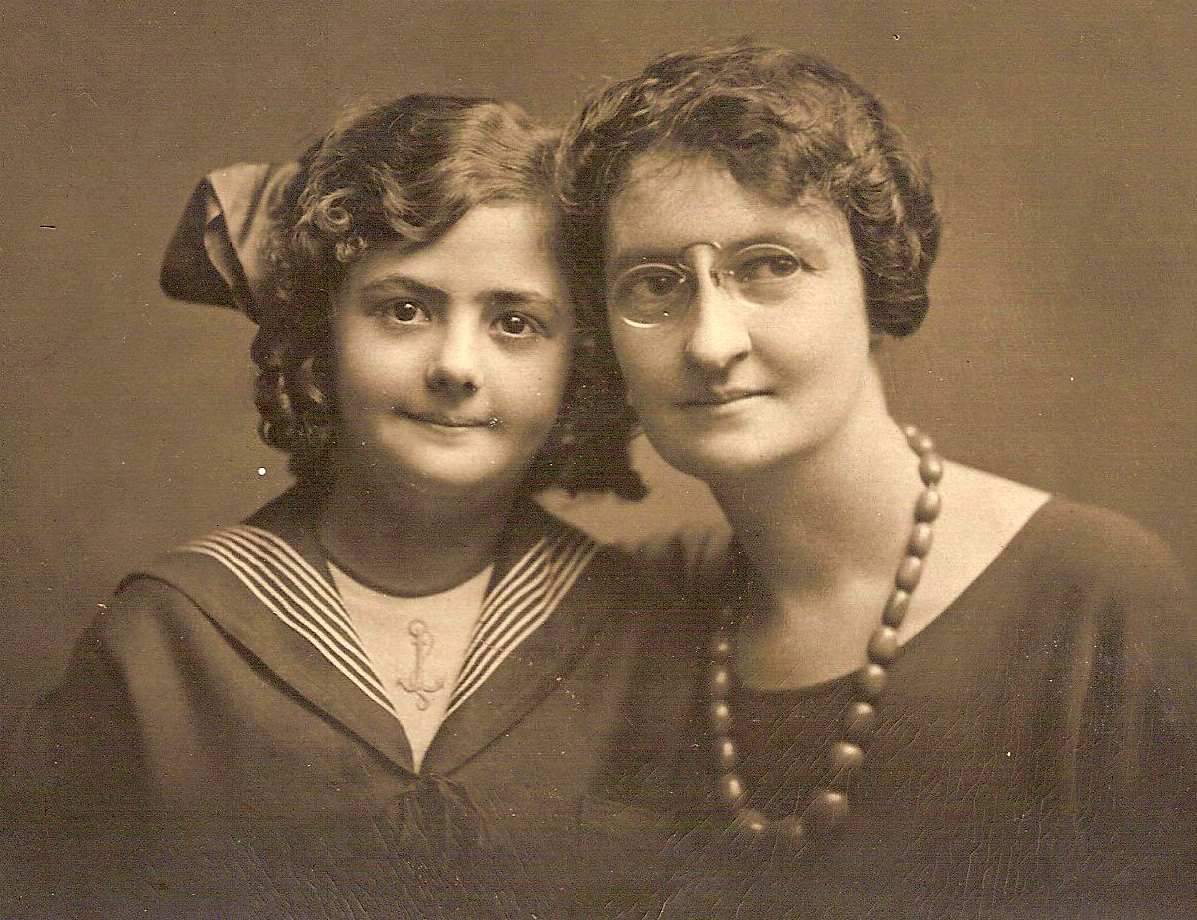
Florence and Esther Duryeas, 1920s
 “Near East Relief Needs are presented: Mrs. Florence Spencer Duryea Addresses Meeting of
“Near East Relief Needs are presented: Mrs. Florence Spencer Duryea Addresses Meeting of
Minneapolitans Interested in Work.” Star Tribune, Minneapolis, Nov. 26, 1919, p. 11
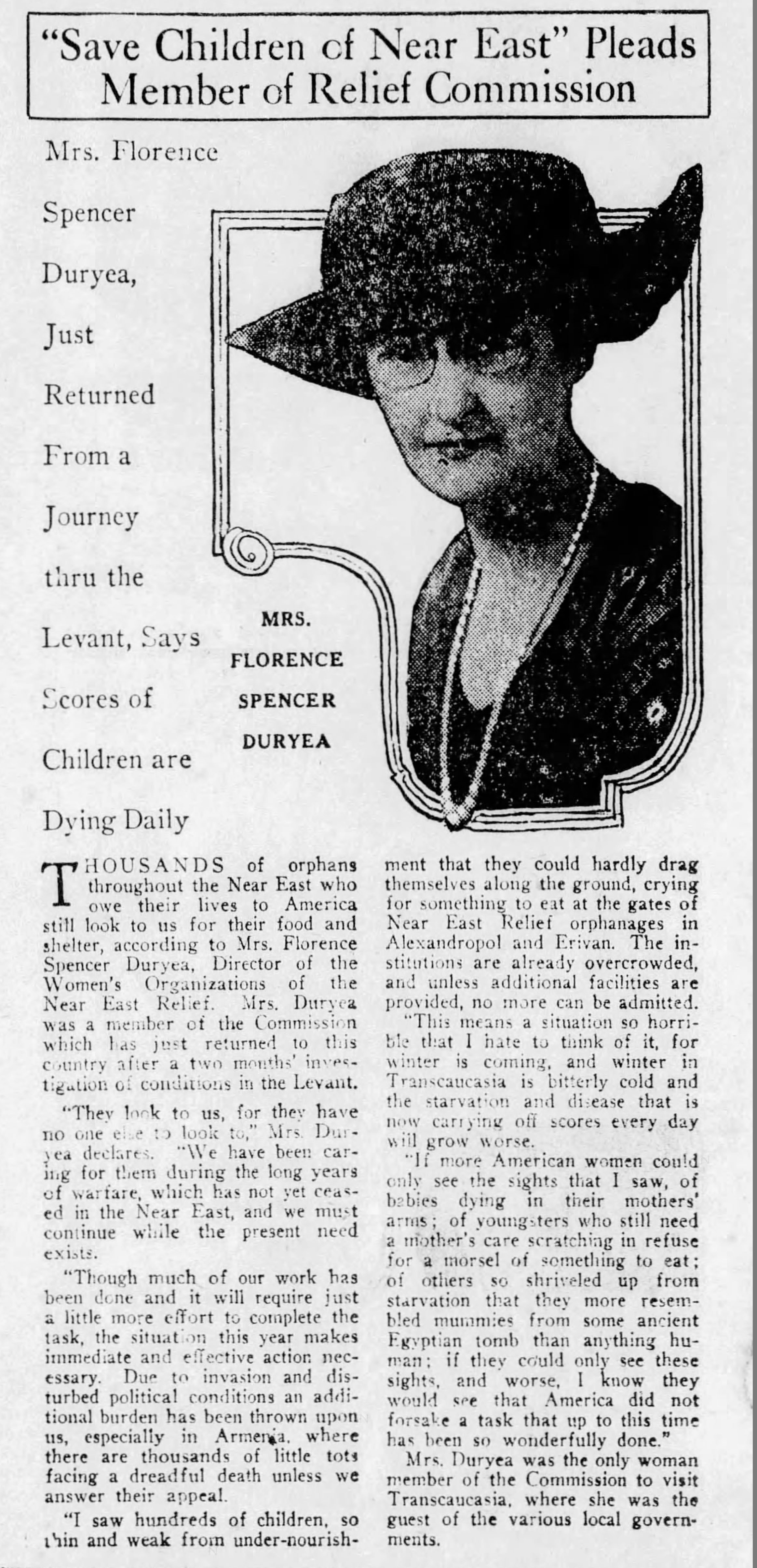 “Save Children of Near East” Pleads Member of Relief Commission.” The Winona Times, Winona, March 3, 1922, p. 6.
“Save Children of Near East” Pleads Member of Relief Commission.” The Winona Times, Winona, March 3, 1922, p. 6.
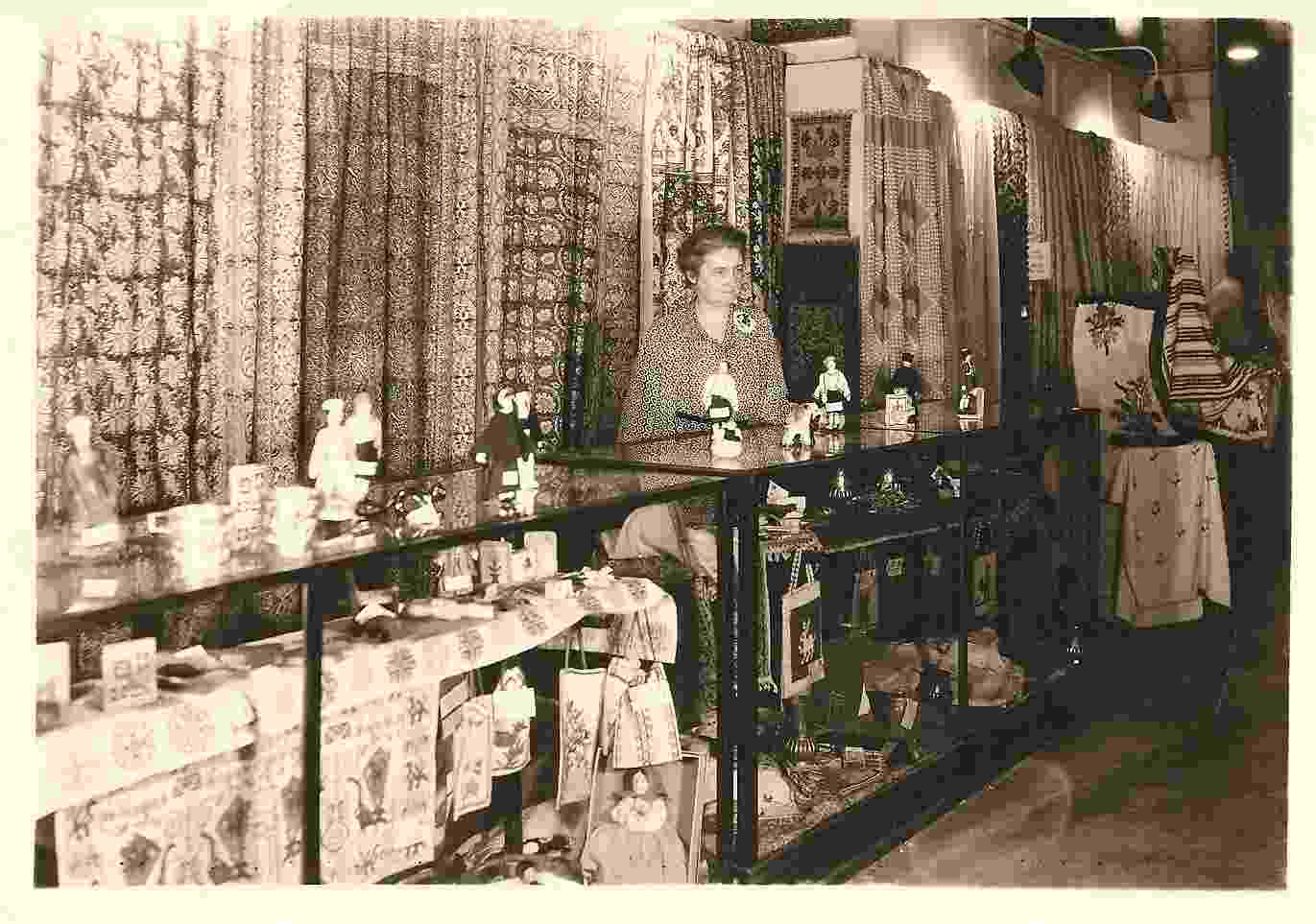
Mrs. Duryea holds a sale for the Near East Relief Foundation. Goods were made in the Near East by people involved with and helped by the Bear East Relief Foundation. 29 June, 1935.
Source: https://en.wikipedia.org/wiki/File:NER_sale.jpg





